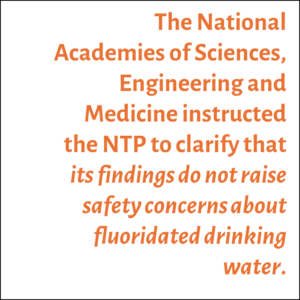Does Fluoride Lower IQ Scores?
 America has been preventing tooth decay with fluoridated water for over 75 years. Fluoridation is effective, safe and benefits everyone regardless of age or income. About 3 out of 4 people in U.S. communities enjoy fluoridated water. Until recently, questions about fluoride and IQ were rare.
America has been preventing tooth decay with fluoridated water for over 75 years. Fluoridation is effective, safe and benefits everyone regardless of age or income. About 3 out of 4 people in U.S. communities enjoy fluoridated water. Until recently, questions about fluoride and IQ were rare.
Studies from New Zealand and Sweden showed that the IQ scores of adolescents and adults living in fluoridated communities during infancy and childhood were no different than the scores of people who lived in communities without fluoridated water. These two studies are unique because they followed participants and tracked IQs and other possible effects over time, well into adulthood.
Opponents of fluoridation began focusing on IQ after the 2012 publication of a systematic review of 27 studies. Opponents claimed that this review showed that lower IQ scores in children were “caused” by fluoride. There are many reasons why the evidence does not support this claim.
- This research review did not test cause and effect. The authors examined a variety of dissimilar studies from China, Mongolia and Iran and reported what was observed. None of these studies followed children into adulthood.
- The authors warned that the studies they reviewed “had deficiencies, in some cases rather serious, which limit the conclusions that can be drawn.” They cautioned that further research would be needed to rule out other factors affecting test scores, such as nutrition, the quality of schools, and the presence of contaminants such as lead.
- The studies did not describe the water that American children drink. The fluoride in these countries was in some cases more than 5 times the level used for water fluoridation in the United States.
- The authors did not consider the possibility of reverse causality. In other words, parents of above-average IQ and financial means, who could create home conditions that favor higher IQ, may have relocated from high fluoride areas before having children. Likewise, families may have departed areas with fluoride levels that markedly exceed the World Health Organization’s standards to avoid dental and skeletal fluorosis that can occur in those places. As a result, the average IQ in those communities could appear to be lower simply because these families were absent, not because of any neurological effects of the fluoride.
The Research Focus Shifts
In recent years, opponents have focused on prenatal exposure to fluoride, with studies from Mexico City and Canada, where fluoride exposure is similar to U.S. and Canadian communities. These studies reported some differences in the IQ scores of 3 and 4 year olds related to the level of fluoride their mothers were exposed to using maternal urinary fluoride (MUF) spot samples. However, the Canadian study only showed a significant difference for boys — and only on one of the two tests.
Many issues have been raised about the quality of the studies from Mexico City and Canada and, importantly, the results have not been confirmed by other research teams.
The Canadian studies are based on a single data set that was not designed to support studies of how a mother’s exposure to fluoride might affect the IQ of offspring. A recently published analysis cites authoritative sources that dismiss the validity of both the measure of the individual mothers’ exposures to fluoride and how the IQs of their children were tested.
Any study of IQ differences must take into account the many factors that can affect intelligence scores. Some of these include breastfeeding, nutrition, and mothers’ IQ. Researchers work to account for these factors to increase confidence that a study’s results are not skewed or otherwise affected.
The studies from Mexico City and Canada accounted for some but not all these factors. They relied on IQ testing that was conducted at only one age. By contrast, the New Zealand study tested IQ several times, starting at age 7 and ending at age 38. The fact that multiple test scores were collected, and over a long period time (31 years), means that we can have more confidence in these results over others.
The National Academies Weighs In
 In 2015, the National Toxicology Program (NTP) initiated a review of studies on fluoride, including those from Mexico City and Canada, and possible cognitive effects. Since then, the NTP has produced several drafts of a report on their findings. As is customary, the NTP sought peer-review of its work, choosing the National Academies of Sciences, Engineering and Medicine. After its reviews, the National Academies concluded that the NTP had not identified “clear and convincing” evidence to support its claim that fluoride causes low IQ.
In 2015, the National Toxicology Program (NTP) initiated a review of studies on fluoride, including those from Mexico City and Canada, and possible cognitive effects. Since then, the NTP has produced several drafts of a report on their findings. As is customary, the NTP sought peer-review of its work, choosing the National Academies of Sciences, Engineering and Medicine. After its reviews, the National Academies concluded that the NTP had not identified “clear and convincing” evidence to support its claim that fluoride causes low IQ.
Consequently, NTP removed the classification of fluoride as a “hazard”. Going one step further, the National Academies instructed NTP to clarify several important points. For example, the studies it reviewed do not address or raise safety concerns about low fluoride exposures, “including those typically associated with drinking-water fluoridation.” The revised draft also presented an opportunity to include research, some contradictory, published through November 2021.
The third draft, entitled NTP Monograph on the State of Science, was not resubmitted to the National Academies. Instead it was given to the NTP’s own Board of Scientific Counselors (BSC). They assessed the adequacy of NTP’s responses to the comments received from expert reviewers. The BSC recommended an additional 93 revisions to the monograph due to 1) scientific issues, 2) insufficient information, 3) imprecise text, and 4) the need for additional research.
Since the BSC’s recommendations were made, still more concerns have been raised about the monograph, this time about the validity of several studies upon which the report’s conclusions were based. NTP staff are currently making those revisions; a final report has yet to be released.
Other Studies Offer Insights
In 2021, a study from Spain found that mothers’ prenatal fluoride exposure was associated with higher cognitive scores in boys at age 4, not lower. There was no difference in girls’ IQ. This contradicts the findings of the 2019 Canadian study. A much larger 2022 study in Australia followed boys and girls with different lifetime fluoride exposures from birth to age 5. This study assessed the children’s emotional and behavioral development later before they reached age 18. Their conclusion? Exposure to fluoridated water during the first five years of life was not associated with altered measures of child emotional and behavioral development and executive functioning.
More than 6,800 studies and research papers have been produced on fluoridation, and the overwhelming evidence shows its safety and benefits. Water fluoridation has been and continues to be thoroughly evaluated to ensure the health of those who benefit from it.

